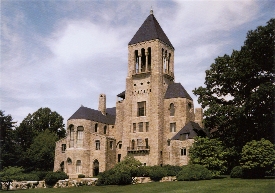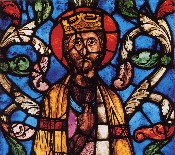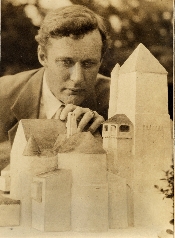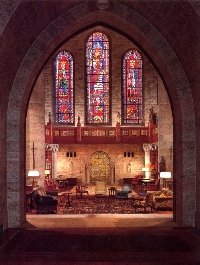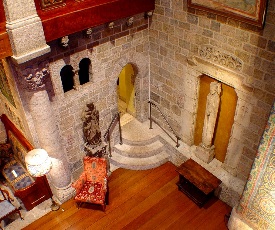Glencairn Museum, Bryn Athyn, Pennsylvania:
History and Mission
Ed Gyllenhaal
Material Religion 2.1 (2006): 132–136.
This article was originally published in Material Religion: the Journal of Objects, Art and Belief (ISSN: 1743-2200), a refereed journal that seeks to bridge the worlds of scholarship and museum practice, and to support those seeking to understand and explain the relationships between objects, art and belief. Glencairn, completed in 1939, was once a private home. Now Glencairn Museum, it is known internationally for its outstanding collection of religious art, used to educate visitors about religious life through the ages. The museum also seeks to preserve and interpret the art, culture, and history of the New Church. To download this article as an Adobe Acrobat (pdf) file, click here (504 KB).
Glencairn Museum, Bryn Athyn, Pennsylvania. Photo Glencairn Museum. Click on image for a larger version.
On the morning of 9-11 a group of history students from a Christian school in Pennsylvania traveled to Glencairn Museum for a lesson about Islamic thought and culture, including the nature of Allah, the importance of daily ritual prayer, and the role of women in Islamic countries. In the words of one of them, now a young woman in college,
I learned about the attacks right after the trip. There was a lot of confusion, but when we figured out that the terrorists were Muslims, I never associated those people with what we had learned. The understanding of the religion I received at Glencairn made me sympathize with other Muslims—the ones who had nothing to do with the attacks. When I picture the rituals I picture good people, not bad people. I think that it was good to have that image established before all of the negative press the Islamic faith got.
Glencairn Museum stands on a hill in the picturesque borough of Bryn Athyn, just a mile from the Philadelphia border. Bryn Athyn was founded as a religious community in the late nineteenth century by members of a Christian denomination known as the New Church. Glencairn, a "castle" built between 1928 and 1939 in a style based on medieval Romanesque architecture, is the former home of Raymond and Mildred Pitcairn, two prominent members of the Bryn Athyn congregation. The building now serves as a museum of religious art and history. The New Church faith that inspired this unusual museum had its origins in eighteenth-century Sweden, with the spiritual journey of a scientist, philosopher, and theologian named Emanuel Swedenborg.
Emanuel Swedenborg (1688–1772) was born in Stockholm, Sweden. The son of a prominent Lutheran bishop, Swedenborg was educated at the University of Uppsala. He went on to publish a series of books that established his reputation in Europe as a scientist and philosopher of the first rank. Then, in 1743, at the age of 55, Swedenborg began to experience a series of religious visions that completely changed his life. He shifted his focus away from science and philosophy, and spent the rest of his life writing twenty-five volumes of systematic theology. Although Swedenborg himself never attempted to found a religious organization, New Church groups based on his writings began to appear shortly after his death. His writings were especially well received in nineteenth-century America, and Philadelphia was one of the earliest centers of New Church activity.
In 1876, together with a small group of supporters, the Reverend William Henry Benade (1816–1905) and industrialist John Pitcairn (1841–1916) established the Academy of the New Church in Philadelphia. In an effort to develop a comprehensive system of New Church education, the Academy opened a Divinity School for training ministers, a College, a Boys' School and a Girls' School. In 1877 Benade and Pitcairn left the country on an extended tour of Europe, Egypt, and the Holy Land. Their purpose was to spread the word about the New Church and the Academy and to see for themselves the land of the Bible, which Swedenborg had written about. However, they returned home with something unexpected—more than 1,000 artifacts from the ancient world, purchased, according to Benade, "for the purposes of mythological study" (Rome, November 2, 1878). Benade wrote home that "these things will make the beginning of a Museum for the Academy. I hope that all our friends will bear in mind that we shall need a Museum, and will collect whatever they can find that may be of use for such a purpose" (Rome, December 4, 1878). Of their trip along the Nile, Benade wrote that "the pictures on the walls of some of the Temples, all of them religious, are lovely in the extreme, not so much as mere works of art, but as expressions of the sentiment of profound reverence for the Divine Being, coupled with a deep, confiding love" (Cairo, April 7, 1878).
Why would a nineteenth-century Christian minister admire the religion of ancient Egypt, with its perplexing variety of gods and goddesses? Instead of seeing Christianity as the only true religion, Benade accepted Swedenborg's teaching that the spiritual history of the world was a succession of ecclesiae ("churches") or spiritual epochs, each of which had received its own form of divine revelation. To Benade and Pitcairn, the tombs and temples of ancient Egypt were an inspiring attempt to connect with the one true God, a God who had been accessible to all people throughout human history. In New Church belief, God is effectively present in all religions, and people of all faiths are welcomed into heaven after death as long as they have lived a good life according to what they have sincerely believed to be God's will.
While Benade and Pitcairn could be considered co-founders of the museum, the most significant contribution to its history would be made half a century later by John's son, Raymond Pitcairn (1885–1966). When Raymond was still a boy, the Philadelphia New Church congregation and the Academy relocated to the countryside in the Pennypack Creek valley. They named their new community Bryn Athyn, or "Hill of Unity." A substantial donation from the Pitcairns made it possible to begin work on Bryn Athyn Cathedral in 1913. Raymond took over the supervision of this ambitious building project after his father's death in 1916, and the construction of a New Church cathedral was to become his chief occupation for the next twelve years. A cluster of shops for working stone, wood, and metal grew up around the cathedral. The subject matter of the stained glass windows was to be based entirely on New Church teachings, and Pitcairn was determined to duplicate the textures and pure colors of the medieval glass he had admired in European churches. To accomplish this, however, it soon became clear that the craftsmen would need hands-on access to actual medieval windows. Pitcairn began buying medieval glass panels at auctions in New York and from dealers in Europe and America. In time his glass collection would grow to include more than 260 panels and he became an art collector of international importance. Pitcairn continued to collect extensively throughout the 1920s and 1930s and broadened the scope of his collection by purchasing hundreds of examples of medieval sculpture. Bryn Athyn's stained glass artists and stone carvers were now provided with many works of art from the medieval period as a source of information and inspiration. Today the Pitcairn medieval collection is regarded as one of the finest in the country.
King from a thirteenth-century Tree of Jesse window depicting the royal genealogy of Jesus Christ (see Isaiah 11:1). From Soissons, France, Cathedral of Saint-Gervais-et-Saint-Protais. Photo Glencairn Museum. Click on image for a larger version.
As a Christian, Pitcairn had a natural affinity for the religious symbolism found in many of the medieval works that he owned, especially ones depicting stories from the Bible. But as a member of the New Church, Pitcairn believed that God had been present in even the most ancient religions. It may have been for this reason that his collecting interests broadened as time went on. In addition to Christian art, Pitcairn acquired art from ancient Egypt, the ancient Near East, ancient Greece and Rome, and a few objects from Asian and Islamic cultures.
Raymond Pitcairn (1885–1966) looking at an early model of Glencairn. Photo Glencairn Museum. Click on image for a larger version.
As the cathedral project began to wind down in the late 1920s, Pitcairn began to consider how to provide his art treasures with a proper setting. Above all else, Glencairn was intended as a home for his family, and it was designed so that the children's rooms would have an excellent view of Bryn Athyn Cathedral. Glencaim's Great Hall and Upper Hall feature dozens of medieval sculptures (built into the fabric of the walls and also freestanding), medieval stained glass panels mounted in windows to receive natural light (including six full-scale replicas of windows in Chartres Cathedral, some of which are 22 feet high), together with frescoes, paintings, tapestries and oriental rugs from a variety of periods. Pitcairn intended these works of art to exist in aesthetic harmony with the hundreds of images in stone, wood, stained glass, and mosaic that were inspired by the teachings of the New Church and created by Bryn Athyn craftsmen. The Pitcairn family moved into Glencairn in 1939. Raymond died in 1966 and the home remained in the family until the death of his wife, Mildred, in 1979. At this time the modest holdings of the Academy's museum (which until then had been housed in a room of the library) were moved to Glencairn and merged with the impressive Pitcairn collections to create what is now known as Glencairn Museum. Along with the new collections and the remarkable facility in which to preserve, exhibit, and interpret more than 10,000 objects, the Glencairn Foundation provided the museum with an endowment sufficient to hire a full-time, professional staff.
The north wall of Glencairn's Great Hall. The north and west walls feature six full-scale replicas of windows in Chartres Cathedral, five of which were reproduced from nineteenth-century tracings made directly from the glass at Chartres. The east wall is filled with original panels of French stained glass from the twelfth and thirteenth centuries. Photo Barry Halkin. Click on image for a larger version.
Today Glencairn Museum continues its primary role as a teaching museum, with a mission that has remained essentially unchanged since Benade and Pitcairn founded it. The opening paragraph of the most recent version of the mission statement reads as follows:
Glencairn Museum exists to educate a diverse audience about the history of religion, using art and artifacts from a variety of cultures and time periods. We seek to build understanding between people of all beliefs through an appreciation of common spiritual history and values. The Museum's special focus is to preserve and interpret the art, culture, and history of the New Church.
In the 1990s the museum began to further explore the potential suggested by its mission. Glencairn began to offer more guided tours, concerts, lectures, and special events to the general public and it became a popular destination for classes from public and private schools. While the museum's staff welcomed the opportunity to reach out to new audiences, this development also presented certain challenges. American public schools have been downplaying the role of religion in the classroom since the 1970s. In the words of one Glencairn Museum educator, in the early years "public school teachers would say to me, 'You're not going to talk about God are you? We aren't allowed to talk about religion, you know.'"
This problem was complicated by the fact that the topic of religion has traditionally been avoided by our peer institutions. While museums contain many of the world's greatest examples of religious art and artifacts, it is difficult to leave a typical art museum having learned very much about the religious motivations that lie beneath the objects. Where was Glencairn, an institution with the expressed goal of being a "religion museum," to look for role models? We were delighted to discover the groundbreaking book Godly Things: Museums, Objects and Religion (edited by Crispin Paine, 2000). We also began to notice the opening of other "religion museums," notably the St. Mungo Museum of Religious Life and Art in Glasgow, Scotland (1993), and the Museum of World Religions in Taipei, Taiwan (2001). This seems to us to represent a tide change, a transformation we have also observed in talking to public school teachers, who now feel more free to include religion in their lesson plans. According to one of our museum educators, "I no longer hear objections to discussing religion; in fact, the teachers welcome a forum that ties religion into their history curriculum."
Glencairn Museum's galleries, many of which are housed in former family bedrooms, include spaces devoted to Ancient Egypt, the Ancient Near East, Ancient Greece, Ancient Rome, Asia, American Indians, and several galleries for medieval stained glass, sculpture, and treasury items. A special study gallery focuses on artists influenced by the writings of Emanuel Swedenborg. Over the past ten years, many of the galleries have been reinstalled to make the museum's religious focus more explicit. For example, the Egyptian gallery features special exhibits on mythology, the pantheon, and funerary magic, as well as two miniaturized dioramas—one illustrating the ritual aspects of mummification and another depicting the mythical judgment of the dead in the afterlife. In the Ancient Near East gallery, a detailed model of the tabernacle of Israel explains the biblical context of the tabernacle and the rituals associated with it. The Greek and Roman galleries focus on the role of religion in society by presenting religious objects within their broader cultural context. A new exhibit space is being planned that will accommodate two or three temporary exhibits per year, each on a different religious theme.
Glencairn's Great Hall and Upper Hall feature dozens of medieval Christian sculptures, some of which are built into the fabric of the building. Photo Christopher Smith. Click on image for a larger version.
In the area of public programs, the "Highlights Tour" interprets Glencairn from two different (but complementary) perspectives: as a museum of religious art and as the former home of a New Church family. Several special "History of Religion Tours" (for example, "Life in the Afterlife" and "Angels, Devils and Spirits") have been designed to show how, throughout human history, art has served as a concrete expression of the religious worldview of the artists who created it. Glencairn Museum also offers lectures, concerts, and a variety of other programs for the general public. Lecture topics have been wide-ranging, including Pre-Rabbinic marriage ritual, The Da Vinci Code, and Swedenborg's global influence, and a discussion was held about Wisdom from World Religions with the author, Sir John Marks Templeton.
However, we believe we have only begun to explore the possibilities implied by our mission statement. The interpretation of the visual culture of religions can be a tricky business and we often feel the need for outside help—not only from art historians, cultural historians, and modern adherents of these religions, but from other educators who find themselves on the "front lines." We would welcome a network or organization for professionals at museums and historic sites who are interested in interpreting religion for the general public.
